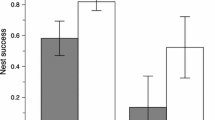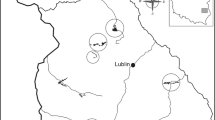Abstract
Based on empiric data of breeding success and accurate number trends in The Netherlands, a population model for the black tern was constructed. This model is based on Leslie matrices. Reproductive parameters from the four most important landscape types (river landscape, agricultural grasslands, peat marsh and heath land/moors) are used as model input. Highly accurate national population trend data were used to obtain the best (least square) estimate of overall adult and subadult survival (resp. 0.849 and 0.595). Estimating survival parameters in this way might be useful for threatened (bird) species, especially if catching and ringing is difficult or less desired from a conservation perspective. The model shows the actual importance of the river landscape as the main source for reproductive output of the Dutch black tern population. The prediction model was subsequently used to test different conservation strategies for the Dutch black tern population. Conservation strategies ranged from a null scenario (no change in conservation effort) to in- or decreasing the number of rafts in the most productive landscape (river landscape) to a scenario where breeding success is improved recently in agricultural grasslands via minimizing disturbance. For all scenarios, the model predicts a slow to rapid population increase in the Dutch black tern population after 10–20 years. Improving breeding success in agricultural grasslands habitat has the highest added value.




Similar content being viewed by others
References
Beintema AJ (1996) Succes en falen van de zwarte stern in Ooypolder, Ankeveen, Bargerveen, Polder Demmerik. IBN-DLO, Instituut voor Bos- en Natuuronderzoek, Arnhem
Beintema AJ (1997) European black terns (Chlidonias niger) in trouble: examples of dietary problems. Colon Waterbirds 20:558–565
Beintema AJ, Baarspul T, Krijger JP (1997) Calcium deficiency in black terns Chlidonias niger nesting on acid bogs. Ibis 139:396–397
Cramp S (ed) (1985) The birds of the Western Palearctic 4. Oxford University Press, Oxford
Ebbinge BS, Heesterbeek HJAP, Ens BJ, Goedhart PW (2002) Density dependent population limitation in dark-bellied brent geese Branta b. bernicla. Avian Sci 2:63–75
Ezard HG, Becker PH, Coulson T (2006) The contributions of age and sex to variation in common tern population growth rate. J Anim Ecol 75:1379–1386
Gonzalez-Solis J, Wendeln H, Becker P (1999) Within and between season nest-site and mate fidelity in common terns (Sterna hirundo). J Ornithol 140:491–498
Hötker H, Van der Winden J (2005) Numbers, distribution and protection of black terns Chlidonias niger breeding in Germany 1990–2003 with comparison to the Netherlands. Vogelwelt 126:179–186
Lebreton J-D, Clobert J (1991) Bird population dynamics, management and conservation: the role of mathematical modelling. In: Perrins CM, Lebreton J-D, Hirons GJM (eds) Bird population studies. Oxford University Press, Oxford, pp 105–125
Lebreton JD, Hines JE, Pradel R, Nichols JD, Spendelow JA (2003) Estimation by capture-recapture of recruitment and dispersal over several sites. Oikos 101:253–264
Leslie PH (1945) On the use of matrices in certain population mathematics. Biometrika 33:132–212
Niehues F-J, Schwöppe M (2001) Die Trauerseeschwalbe: eine vom Aussterben bedrohte Art. Nistflösse verhelfen den Trauerseeschwalben zur Rückkehr nach Nordrhein-Wetsfalen. LÖBF-Mitteilungen 2:28–35
Nisbet ICT, Winchell JM, Heise AE (1984) Influence of age on the breeding biology of common tern. Colon Waterbirds 7:117–126
Paradis E, Baillie SR, Sutherland WJ, Dudley C, Crick HQP, Gregory RD (2000) Large-scale spatial variation in the breeding performance of song thrushes Turdus philomelos and Blackbirds T. merula in Britain. J Appl Ecol 37:73–87
Russel RW (1999) Comparative demography and life history tactics of seabirds: implications for conservation and marine monitoring. Am Fish Soc Symp 23:51–76
Servello FA (2000) Population research priorities for black terns developed from modelling analyses. Waterbirds 23:440–448
Staav R (1998) Longevity list of birds ringed in Europe. EURING Newsl 2:9–17
Tucker GM, Heath MF (1994) Birds in Europe: their conservation status. U.K. Birdlife International (Birdlife Conservation Series no. 3), Cambridge, pp 304–305
Van Dijk AJ, van der Weide M, Kleefstra R, Zoetebier D, Plate C (2002) Kolonievogels en zeldzame broedvogels in Nederland in 1999. Limosa 75:103–122
Van der Winden J, Hagemeijer W, Terlouw R (1996) Heeft de zwarte stern Chlidonias niger een toekomst als broedvogel in Nederland? Limosa 69:149–164
Van der Winden J, Viksne J (1997) Black tern Chlidonias niger. In: Hagemeijer EJM, Blair MJ (eds) The EBCC atlas of European breeding birds: their distribution and abundance. T & A D Poyser, London, pp 364–365
Van der Winden J (2002a) Disturbance as an important factor in the decline of black terns Chlidonias niger in The Netherlands. Vogelwelt 123:33–40
Van der Winden J (2002b) Zwarte stern Chlidonias niger. In: SOVON Vogelonderzoek Nederland. Atlas van de Nederlandse Broedvogels 1998–2000. Nederlandse Fauna 5:256–257. Nationaal Natuurhistorisch Museum Naturalis, KNNV Uitgeverij & European Invertebrate Survey-Nederland, Leiden
Van der Winden J (2002c) The odyssey of the black tern Chlidonias niger: migration ecology in Europe and Africa. Ardea 90:421–435
Van der Winden J (2003) Ringonderzoek aan de zwarte stern Chlidonias niger in het Groene Hart. Het Vogeljaar 52:155–161
Van der Winden J, Beintema AJ, Heemskerk L (2004) Habitat related black tern Chlidonias niger breeding success in the Netherlands. Ardea 92:53–62
Van der Winden J (2005) Black tern Chlidonias niger conservation in the Netherlands––a review. Vogelwelt 126:187–193
Wendeln H, Becker PH (1998) Populationsbiologische Untersuchungen an einer Kolonie der Flussseeschwalbe Sterna hirundo. Vogelwelt 119:209–213
Acknowledgments
Vogelbescherming Nederland gave financial support in the framework of the Dutch Marshland Protection Plan. S. Dirksen gave useful comments on the earlier versions of this paper. Suggestions of two anonymous referees were also used to improve the paper. P. Szczys kindly gave comments on the manuscript and revised the English. Many persons and institutes supplied information about breeding numbers or breeding success with special thanks to Sovon for Dutch census data and Natuurmonumenten and Staatsbosbeheer for permission to study black terns in their reserves.
Author information
Authors and Affiliations
Corresponding author
Additional information
Communicated by P.H. Becker.
Rights and permissions
About this article
Cite this article
van der Winden, J., van Horssen, P.W. A population model for the black tern Chlidonias niger in West-Europe. J Ornithol 149, 487–494 (2008). https://doi.org/10.1007/s10336-008-0292-z
Received:
Revised:
Accepted:
Published:
Issue Date:
DOI: https://doi.org/10.1007/s10336-008-0292-z




